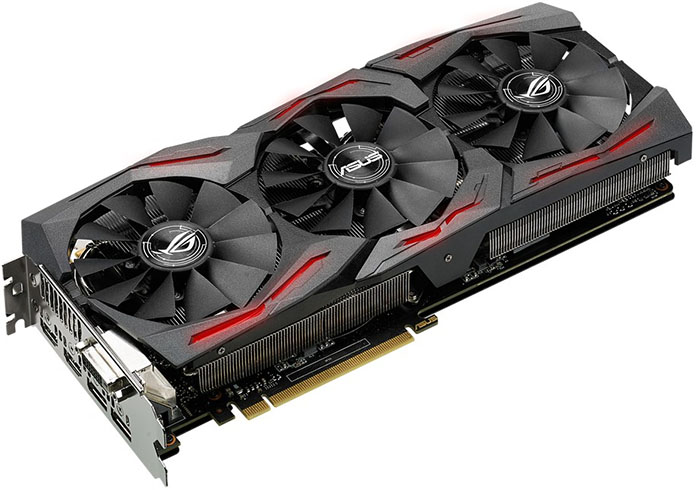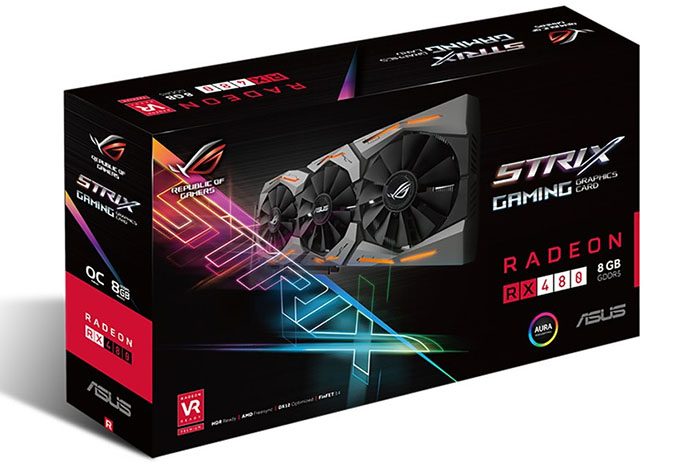AMD announced the Radeon RX 480 to much fanfare. The new mid-range graphics card is the first based on its 14-nm Polaris GPU, and it brings VR-ready performance to a more affordable price than ever before. Unfortunately, the first cards were based on an AMD reference design that’s had some teething problems. We’ve been working on a custom ROG Strix RX 480 that not only avoids those issues, but also delivers faster performance, superior cooling, and customizable lighting.
While our ASUS-exclusive enhancements separate the Strix from the rest of the RX 480 field, the star of the show is still the Polaris 10 GPU. The chip is clocked up to 1266MHz in the reference card, and we boost it to 1310MHz in the Strix’s default gaming mode. You can also increase the GPU frequency to 1330MHz with a single click by activating the OC profile in our GPU Tweak II software. Manual overclocking is supported, too, if you prefer to handle the tweaking yourself.
 Beefed up GPU power
Beefed up GPU power
The GPU is fueled by Super Alloy Power II components with more overclocking headroom than conventional parts. Even at stock speeds, these components improve power efficiency and reduce buzzing. They’re laid out with mechanical precision by Auto Extreme Technology, a fully automated manufacturing process that ensures more consistent quality from one card to the next. This process is also more environmentally friendly than traditional manufacturing, requiring half the power—and none of the harsh chemicals.
On the reference card, the GPU draws power from both the motherboard’s PCI Express slot and the six-pin connector for the PSU. This arrangement initially exceeded the specifications for both interfaces, prompting AMD to issue a driver update that shifts more power to the external connector. While the change lowers power draw from the motherboard slot, the external connector still pulls more than the 75W prescribed by the spec.
The Strix RX 480 replaces the GPU power circuitry with a six-phase solution fed exclusively by an eight-pin connection to the PSU. The eight-pin jack is rated for 150W, which is more than enough to handle the power draw. Other parts of the card, like the 8GB of GDDR5 memory at 8Gbps, are powered by the motherboard slot. The power draw for these components is low enough to stay well within the spec.
Illuminated cooling
Because the GPU is clocked higher than on the reference card, it consumes more power and produces more heat. You might expect the Strix to run hotter and louder as a result, but our DirectCU III cooler is much more capable than the reference design. Internal testing shows that the Strix runs 16°C cooler and five decibels quieter than the standard RX 480 in 3DMark11. Under lighter loads, like casual gaming and web browsing, the 0dB fans spin down completely to make the card blissfully silent.
Our intelligent cooling isn’t just for the fans on the card itself. The Strix also has dual FanConnect headers that bring system fans into the fold. System fans are typically controlled by the temperature of the CPU or motherboard sensors, an approach works well for CPU-intensive tasks. But games disproportionately heat up the GPU, resulting in inefficient cooling when most rigs need it most. Enter FanConnect, which controls system fans with a dedicated profile based on the GPU temperature.
The headers detect the presence of three- and four-pin fans and adjust accordingly, so they’ll work with pretty much any fan in your system. And, just like with the fans on the card, you can easily tweak the response profile with GPU Tweak II. Whether you want to add auxiliary fans to pursue higher overclocks or connect existing ones to optimize gaming thermals, FanConnect makes graphics cooling smarter than ever before.
While the Strix RX 480’s cooling enhancements are purely functional, its Aura lighting is largely for looks. RGB LEDs embedded in the fan shroud and backplate provide customizable illumination visible from just about any angle. With millions of colors on tap, it’s easy to match the lighting with other system components for a cohesive overall look. You can choose between multiple effects, including a steady glow, breathing, strobing, and color cycling. There are also additional effects that pulse to the beat of music and change color based on the GPU temperature.
The ROG Strix RX 480 is just one member of a growing family of Aura-enabled products. Future software updates will enable synchronized colors and effects across these components, so you can easily coordinate the lighting for an entire system. If RGB LEDs are going to be integrated into everything, they should work together, and we’re uniquely positioned to make that happen.

Ready for VR
Virtual Reality is the future, so we’ve designed the Strix with that in mind. The card has dual HDMI 2.0 ports to let you connect a monitor and headset simultaneously—no more switching cables! Monitors can also connect via DVI or dual DisplayPort 1.4 outs.
Whether you’re in VR or using a conventional monitor, gaming is increasingly becoming a shared experience. To give streamers a head start, we’ve bundled the Strix RX 480 with a one-year XSplit Gamecast Premium license worth $99. Setting up a broadcast is simple, but cultivating an audience is up to you.
The ROG Strix RX 480 will be available next month in stock and overclocked flavors. Stay tuned for pricing.

